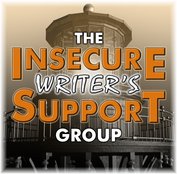
Professional Organizer!
Several times a month, I volunteer to organize donations for a place that allows people in need to select items for free. The room I set up focuses on bedding, towels, and curtains.
 Every month, the Insecure Writers Support Group hosts a blog hop with an optional question. Special thanks to Alex Cavanaugh and to this month’s co-hosts, Patricia Josephine, Diedre Knight, Olga Godim, J. Lenni Dorner, and Cathrina Constantine. This month's question: If you ever did stop writing, what would you replace it with? If I had to stop creating stories, my top career choice would be to teach writing craft instead. But a possible second choice would be . . . Professional Organizer! Several times a month, I volunteer to organize donations for a place that allows people in need to select items for free. The room I set up focuses on bedding, towels, and curtains. When I arrive it looks like this: When I leave, it looks like this: It's rewarding to organize the chaos, knowing clients will be able to easily find the items they want.
Today's productivity advice comes from author Maria E. Andreu, who shares three tips for revision. Thanks, Maria! The Reluctant Revisor’s Guide to Revision by Maria E. Andreu I am a terrible self-editor. I am a lightning-fast drafter and can put out a pretty clean first draft. I wrote my most recent book, JULIETA AND THE ROMEOS, in a month. (It had to go through 3 pretty extensive rewrites, so fast drafting is definitely not the end of the story). This ability to write quickly probably works against me when it comes time for revision. My thinking goes along the lines of, “But I outlined, I sweated, I worked so hard on this draft. I did not get up off the chair for hours on end, and I agonized over so many details. How can it still be ‘wrong’?” Of course, the need to revise has nothing to do with a draft being “wrong.” Books are iterative because they’re complex and layered. We may not even understand all the themes and subplots when we first set out on the journey of getting the story down. Terry Pratchett said, “The first draft is just you telling yourself the story.” Once we’ve told ourselves the story, we can begin to identify where we left gaps, overexplained, repeated ourselves, or created a less-than-compelling character. It’s in the editing that books shine. Because editing feels difficult for me, I’ve gathered a few tools that make it feel less daunting. Without further ado: here are three revision tips for the reluctant revisor. 1. Print your manuscript in a different font and have it bound. Reading as a writer means that I rarely can get absorbed in a new book without deconstructing it. Do I like the author’s choice of words? Is the pacing engaging or plodding? How did they pull off that fantastic reveal? I use this tendency in my favor when editing by trying to “fool” myself into reacting to my own work like a book I’m reading for the first time. Part of what makes revision psychologically difficult for me is that when I’m going through a manuscript, I tend to start skimming or making excuses for myself as I read. I’ll come upon a passage I know needs trimming and I’ll start to tell myself, “Yes, but remember how hard I worked to find that perfect adjective? All that thesaurus work?” Never mind that the whole passage probably needs to go, or is being made obsolete by the removal of a side character. I’ll start to spin about ways I can maybe keep it. But seeing the book in a fresh font can break this logjam for me. If you’re feeling really motivated, you can upload your document to a website like Draft2Digital, which formats manuscripts into book format. Stop just before hitting “publish,” and download the PDF. I’ve gone so far as to send this PDF to a Fedex or Staples to have it perfect-bound. But even just a simple print-out will give you the ability to look at your book with fresh eyes. 2. Toss it in the air. Okay, you don’t have to toss it toss it, but getting pages out of order can help you look at things with fresh eyes. Both JULIETA and my previous book, LOVE IN ENGLISH, contained poetry and other snippets between chapters, and seeing those out of context was particularly helpful. Reading them as stand-alones helped me determine whether they were strong enough without the surrounding material. But even if your book doesn’t contain interstitials and “found” writing, you can still benefit from engaging with it out of order. Think about a potential reader picking it up at a bookstore and flipping through it. Any one page should have the ability to catch a reader’s eye. Some people who do this just shuffle the pages. If this sounds too daunting, staple each chapter separately and shuffle those. This is not a top-line revision strategy – you want to have a pretty solid story before delving down to this level of detail. But when you’re ready, this can be an excellent tool to make every page shine. 3. Invite the character over for tea. I’m a tea drinker, so I like the visual of being able to have a character over for a chat and a spot of tea. And I do tend to ramble on and off for hours with characters while I’m writing, hearing their dialogue and their wants in my head. But, practically speaking, a good way to systematize this is to (you guessed it) write it down. When I’m stuck on a thorny question, or even early on in the process when I’m really just trying to understand this new character who has monopolized my attention, I sometimes take to paper to “chat” with them. I write questions as me. Then I try to absorb them as the character might. Then, I begin to answer in their voice. The questions can be broad, like, “What would be the worst thing that could happen to you?” or “Why do you want [insert character goal]?” But they can be specific, too, like “Do you like pickles?” and “If you could only wear one color forever, what would it be?” Unexpected ideas can come from this stream-of-consciousness “conversation,” so I invite you to give it a try. Remember it’s not you, it’s the book. I am often daunted by reading that so many of my favorite authors talk about how much they hate drafting and how “great books are written during revision.” As someone who finds revision painful, it makes me wonder if I’m a “real” writer. But, the truth is, there are an infinite number of ways to be a writer, and mine is one of them. If you find yourself challenged by revision, know that you are not alone. And, if you can, do your best to separate yourself from the work. If you wrote a clunky chapter, or if your ending is predictable, that doesn’t mean anything about you as a writer, except that there’s more work to do. I often say, during my book events, that furniture makers don’t get furniture maker’s block. They don’t look at a table that wobbles and think, “I’m a failure as a furniture maker. What even made me think that I could make furniture?” They find what’s making the table wobble, and they fix it. Writers could use a bit more of that thinking, especially this writer. These tips apply to other kinds of tasks, too. Looking at other projects from different lenses, and engaging in Q&A with the problem can help you in work tasks, and other creative endeavors as well. For example, I’m a (very amateur) painter and I like to draw. Sometimes, I sit in a different part of the room (like on the floor in a corner) and look at my drawing from there. Stepping back and viewing from another angle can help you see your work differently. Making things is hard. No question about it. Chunking it down and approaching things differently can help you see things in a new light. Happy creating! 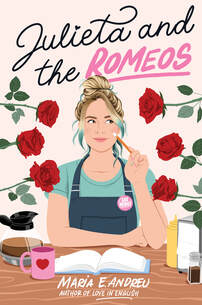 More about Julieta and the Romeos: You’ve Got Mail meets a YA Beach Read with a bookish mystery at its heart. Julieta isn’t looking for her Romeo—but she is writing about love. When her summer writing teacher encourages the class to publish their work online, the last thing she’s expecting is to get a notification that her rom-com has a mysterious new contributor, Happily Ever Drafter. Julieta knows that happily ever afters aren’t real. (Case in point: her parents’ imploding marriage.) But then again, could this be her very own meet-cute? 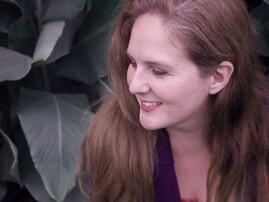 More about Maria: Maria E. Andreu is the author of Love in English, an Indie Next Pick, a YALSA Best Fiction for Young Adults book, and a Bank Street Best Book of the Year. Her debut novel, The Secret Side of Empty, was a National Indie Excellence Book Award winner. Both titles were Junior Library Guild Selections. She is a Red Dead aficionado, a cat herder, and a believer in (and a skeptic of) happy endings. 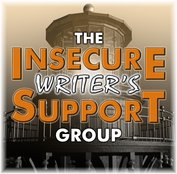 Every month, the Insecure Writers Support Group hosts a blog hop with an optional question. Special thanks to Alex Cavanaugh and to this month’s co-hosts, Joylene Nowell Butler, Ronel Janse van Vuuren, Meka James, Diane Burton, Victoria Marie Lees, and M Louise Barbour. This month's question: When you are working on a story, what inspires you? When I begin a story, I'm often inspired by a character's emotional reaction and growth in the face of a difficult situation. But an additional spin on the question is what inspires us to keep going? When I'm working on a first draft, I set time goals. I want to make steady progress each week toward reaching some version of a completed draft (beginning, middle, and end). I find word count goals frustrating, personally, because cutting words means backward progress, so I always use time. Knowing that I'm reaching the amount of hours designated for that week inspires me to keep working. Once I've completed a very rough first draft, I set times goals for revision, as well. Each layer of revision has a specific focus (pacing, characterization, etc) and again, I use the idea of completing a certain number of hours a week to get through each pass. It doesn't matter how long it takes, by the way -- I just plan to achieve the number of hours I've dedicated to the project for the week. (It also helps to have a weekly back-up slot as productivity expert Laura Vanderkam advises, in case a day is derailed by unexpected events.) I might not always feel like writing when I sit down at the laptop, starting the day's work. But if I've mentally committed to say, three hours of revision, it tends to get done on the day I planned. I think the showing up at the page is what's important. As Elizabeth Gilbert says in Big Magic, ". . . I don't sit around waiting to write until my genius decides to pay me a visit. If anything, I have come to believe that my genius spends a lot of time waiting around for me--waiting to see if I'm truly serious about this line of work." For more thoughts on inspiration and creativity, check out my blog post, The Myth of the Creative Muse. And ICYMI, author Lyn Fairchild Hawks wrote an April guest post, 4 Productivity Hacks for Colorful Writing. One last thing: In For Better Creativity, Spring Clean Your Brain, Kelsey Allagood suggests various ways to declutter your mind, including cleaning your workspace. She says, "I can absolutely tell the difference in my ability to focus when I’m in a clean and organized environment." I agree! How about you?
Today's productivity advice comes from Lyn Hawks, who shares her colorful system of writing and revising. 4 Productivity Hacks for Colorful Writing by Lyn Fairchild Hawks I just heard a guy say he wrote a book in seven days, using AI. I’ve already imagined a future where AI writes books in nanoseconds, so when I heard this, I tried not to panic. Then I asked myself, How do humans who write the “old-fashioned way” even compete? We can’t. We shouldn’t. I won’t. Humans are all the rainbow colors of creativity, chaos, energy, and soul. That essence lives in our books. I believe this essence will always infuse my generative process. I’ll never fully give my process over to AI tools and systems in some sort of productivity perfection. It’s tempting to let machines, assembly lines, and the cogs and wheels of capitalism set the standard for what’s efficient. (Was that writing session “worth your time”? Did you “get a lot done”? Those voices are loud.) I’d like to leave the definition of productivity to me, the creative individual, while also somehow managing to meet the needs of deadlines and ticking clocks. Over the years, I’ve found a process that jives with my love of art and colors. It’s a visual, slightly playful way for me to stay focused and productive. This process brightens my drafting and revision experience. Color coding also leaves me more knowledgeable, confident, and sure of my direction. What does a productive session of writing look like to you? One of my biggest foes and problems to solve is self-doubt. Color coding helps me keep going no matter how rough a draft looks. By the way, you may have already guessed I’m an intuitive writer. Check out the work of Becca Syme on this enlightening podcast interview with author Joann Penn if you want to learn more about this type of writing process. Syme discusses how a lot of conversations about writing uplift those who use one method, which is outlining. The short version is, I write listening to the voices in my head, then I rough-outline (bullet point) my character goals as obstacles, as well as scene sequences and beats, and then revise. Rinse and repeat. I revise in a similar fashion, jumping between rough outlines and manuscript, and also jumping around the manuscript with Command-F/Control F in order to keep threads and arcs going. My very being resists regular use of spreadsheets and outlines. Sure, I’ll give all these a whirl but I am at my core, as Penn says, “a discovery writer.” It’s worked for 8 books and counting! Here are some coloring tips. Full confession: you’re about to see some messy first draft and late-stage writing here. My color coding system
1. Use yellow to mark revision spots Because writing is discovery for me, I need a breadcrumb system during early drafts to signal return spots. I leave myself questions and “UGH REWRITE” messages, then mark these with yellow highlights. Sometimes I do have to argue with that judge-y invisible editor snarking on my shoulder—the one nudging me off the page toward internet research or self-doubt. This editor sounds like a joke my musician partner and I have, a paraphrase of bluegrass musician Jimmy Martin talking about getting snubbed by the Grand Ol’ Opry: “Guess you ain’t got good enough yet.” Highlighting keeps me on track when all the ugly inner voices rail against my writing. I also use this method to keep momentum during a later revision. A lot of new writing happens in late stages, so I remind myself to return. For example, see below an excerpt from a page of my current manuscript, When Pigs Fly, a young adult novel where I’m doing a Revise and Resubmit for an editor. Because I’m doing a big restructure, it’s important to not be too precious with my wording. Any janky new writing I just added, I mark to fix later with the goal in mind. Just get the gist down, I tell myself. Ignore clichés and too much telling. JUST KEEP MOVING. 2. Use 3-4 colors to track desire lines, themes, and/or arcs Do you have a lot of layers to your character motivations? Do you have a lot of themes you want to develop? Do you have various character arcs to track across chapters? You can write these all in spreadsheet rows or you can assign them colors as you revise. That’s me: big casts with lots of 3-D people I’m trying to get from my head onto the page. When I’m revising the opening section of a novel, and I know my ending, I use this method to make sure that “all signs point” to these strong themes, arcs, and desire lines. So I can’t spreadsheet, and I resist much outlining, but I can color code. Here's a snapshot of a system I’m using while writing a historical young adult novel called Here Comes the Dog Parade. The colors are my own choosing, and the wound, desire line, theme, and character goal are marked by pink, green, blue, and yellow.
You can tell I’m intuitive from the way I’ve got questions still spiraling here. TBD, aka “To Be Discovered.” 3. Use yellow and blue to mark showing vs. telling. My college essay consulting with students and my coaching of writers of all ages emphasizes a core skill of knowing how to spot, enhance, and balance the specifics versus the generalizations, aka showing versus telling. One book that’s helped me is Showing & Telling: Learn How to Show & When to Tell for Powerful and Balanced Writing by Laurie Alberts. If you need good definitions of showing and telling, check it out. I use yellow (what I call “gold”) to mark the lines that pop with specifics: sensory detail, dialogue, interior monologue, and more. It’s anything cinematic that creates a movie in a reader’s mind. I use blue to mark the parts where the writer or narrator stands further away from the action, giving sports commentary, aka telling, while not being as specific. Some sentences are a blend of the two, while others are fully living in one category or another. Try marking up a paragraph of your own. I do this with my student’s writing all the time as well as mentor texts. I ask them which parts stick in your brain and which do not. I ask which parts meet the needs of the scene and the reader. I ask which craft techniques make writing memorable. Color code to find that right balance, as Alberts says, in your own writing as well as your beloved authors. There’s no correct percentage balance–and one way isn’t bad and the other good. Telling gets a bad rap often, but consider this: check out the “telling” the voice of Elena Ferrante is, leaning into summary more than scene for so many pages–and yet HBO was able to make cinema, a whole series, from her Neapolitan novels. Her way works. The secret is the voice and the way she loops in and out of time. Whatever keeps the writing fresh makes it memorable. 4. Use the red of Track Changes as motivation. Red pens get a bad rap but here’s how you can turn red on its head. Keeping Track Changes on while working in Microsoft Word (or keeping the Suggesting function on in Google Docs) during a heavy revision helps me stay encouraged. It’s a tiny way to congratulate myself as my spirits flag, showing me the positive signs of revision progress. It’s such a satisfying mouse click when I hit “Accept Change” over and over. Look at all you did! You done good, Lyn! Here’s a draft (messy fourth draft) that will no doubt see many more red lines and letters. A note for folks with color blindness: If you like some of these strategies, I’d recommend using shades of gray scale to create your own system. For example, dark gray to mark your showing, as a sign of “going deep/mining the earth/gold.” Light gray is telling, pulling back into the lighter sky where it’s hard for the reader to imagine what you’re saying. Have fun coloring your manuscript up so you can be the writer that’s most gleefully productive. It’s like being a kid again with your own codes and language as you name your process. Maybe one day there’ll be AI that I as author or editor can command to “find character’s desire line” as it scans a first draft. Maybe AI will be able to “find showing details that will most impact 15 year-olds.” Then maybe it will render me a report, pointing out places for me to dive back in to write better, go deeper. Analytical rather than generative, showing me ways I can be more “Lyn.” Because that’s the mission, isn’t it? For my writing to be the best of me? 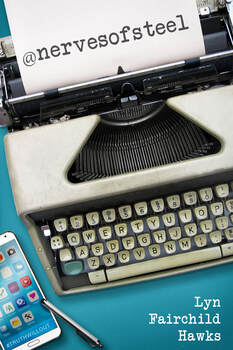 More about @NervesofSteel Minerva, first ninth-grader on her school paper, is ready to be the next Christiane Amanpour. It’s 2013 and Twitter’s a Wild West full of misogynist trolls, bullies Minerva would love to see banned. The biggest troll of all? The hottest guy in school—Chaz, basketball phenom—and he’s doing a full-court press to get with Minerva’s best friend, Diana. Diana wants to fit in, and the whole school seems all in with Chaz and his Hot or Not tournament. When Minerva investigates hazing allegations and tracks tweets to the scene of a kegger, she finds Diana on the fast track to his despicable “Final Four”—a game of no consent. Should @nervesofsteel fight back with reporting like the NYT or like TMZ? Maybe Minerva needs to serve up vigilante justice for a girl who’s feeling like a lot more than a friend. High school in the digital age is harder than Hades, but Minerva’s got nerve to do what it takes so #truthwillout. Check out @nervesofsteel at Amazon, other ebook retailers, or your favorite bookstore or library.  More about Lyn: Lyn Fairchild Hawks is a North Carolina YA author who writes about gifted, weird, and wise activist youth. Her novels include How Wendy Redbird Dancing Survived the Dark Ages of Nought and @nervesofsteel. She is also the author of Minerda, a middle grade graphic novella and collaboration with illustrator Robin Follet; and The Flat and Weightless Tang-Filled Future, a short story collection for adults. Lyn is a recipient of the Norma Fox Mazer Award and an Elizabeth George Foundation grant and an MFA graduate of the Vermont College of Fine Art's program in Writing for Children and Young Adults. A former high school and middle school teacher, Lyn runs Success Story Essay Consulting, helping students applying to college and writing novels express their authentic voices. She is the author of Teaching Macbeth: A Differentiated Approach and Teaching Julius Caesar: A Differentiated Approach (NCTE). She is the co-author of The Compassionate Classroom: Lessons that Nurture Wisdom and Empathy (Chicago Review Press) and Teaching Romeo and Juliet: A Differentiated Approach (NCTE). Find Lyn at lynhawks.com and all the medias social. The Productive Writer: Finding Short Story Markets If you've written short fiction, finding a place to publish it can be time-consuming. Here are four resources to help: The Practicing Writer. One of the best free newsletters. Erika Dreifus curates markets monthly, focusing on those that are fee-free. Authors Publish. Free newsletter that often offers round-ups of markets by theme. Duotrope: One-month free trial, then subscription-based, $50/yr. Weekly newsletter plus database searchable by various categories. Funds for Writers. Free weekly newsletter from C. Hope Clark. The contests, markets, and grants section is at the end. I hope you find these helpful! Mention your own favorite resources in the comments. IWSG Blog Hop: The Windy Career Path
Do you remember writing your first book? What were your thoughts about a career path on writing? Where are you now and how is it working out for you? My first attempt at a novel was THE FLOOD. I was in 5th grade or 6th grade. The fictional water kept rising and rising, but I gave up after a chapter or two because I didn’t know anything about a river flooding, or how to tell such a big story. In the decades that followed, I spent time learning how to research and write a novel. I didn't realize at first how winding the career path could be, but along the way I wrote freelance articles, two nonfiction books for kids (Publishing and Avril Lavigne), and two "in the drawer" novels that won't be published. But the intrigue with a fictional disaster remained. Fast forward to 2014: My debut YA novel, Pandemic was published by Sky Pony Press. And since the actual pandemic occurred, they released a new edition in 2022. Black Flowers, White Lies and several short stories have followed. Now, to help other young writers, I collect information on my Resources for Teen and Tween Writers page. Some of the info is helpful for adult writers, too. :) It's been recently updated, so please check it out. One Last Thing "Spring is the time of plans and projects." ~Leo Tolstoy
Happy Spring! Happy Almost Spring! Resources: I recently updated my Resources for Teen (and Tween) Writers page. (And there's some good stuff there for adult writers, too.) Productivity for Writers: Taking Time Off Sometimes the best way to remain productive is to step away from a project. A break from a novel can be spent writing a short article, an essay, or a poem. And a mini-vacation can also be a way to refill the creative well. According to Psychology Today, "Many argue that some of the most important time to develop creativity and help spark innovation does not occur at work. It occurs in the hours and days we are away from our jobs." Spending time in a new location, having unique experiences, and unplugging are all ways to increase creativity. I find it helpful to wrap up small, outstanding projects before taking any time off. Clearing the decks helps make time away more enjoyable. Motivational speaker Zig Ziglar commented, "Isn't it amazing how much stuff we get done the day before vacation?" and I find that to be true. :)
To fully take advantage of time away from work, some tips from author Brie Schmidt include to wake up early (ugh), avoid filling the time with chores (yay!), and plan your upcoming (or post-vacation) week in advance. (Laura Vanderkam recommends Fridays in general for this weekly planning. Here's why.) Whether you're taking a weekend off or a longer break, I highly recommend leaving yourself good project notes. Then, when you return to your creative work with renewed energy, you can easily dive back in. Writers and Productivity: Don't Wait for Creative Inspiration Writers often talk about waiting for inspiration or a visit from the muse before they sit down to work. They delay the creative process, perhaps inevitably, and definitely longer than necessary. But the best tip is this: Don’t Wait. As Pablo Picasso said, "Inspiration exists, but it has to find you working." If you wait until you’re inspired to create something, days and weeks can pass without doing anything. A better approach is to make a routine that triggers your brain when it’s time to create. Setting up habits takes away the burden of deciding to begin. For example, you could try to write at the same time each day, if possible. Sit in the same place. Lots of writers have a favorite mug filled with coffee or tea nearby. Light a candle or listen to the same music. Have your laptop open and ready to go or write by hand with a favorite pen. (Purple ones are my personal favorite.) Whichever ritual you create, choose something that signals it’s time to begin, even if you don’t feel like it. Particularly then! At the appointed time, get to work. As Stephen King says in On Writing, “This isn't the Ouija board or the spirit-world we're talking about here, but just another job like laying pipe or driving long-haul trucks.” Your routine might change for different parts of the process, and that variety can be a good thing. For example, I might brainstorm ideas outside or a café, draft by hand in my favorite comfy chair, and proofread at a desk which signals focused concentration. But what if you are just . . . stuck? Try one of these: Reread a page from yesterday. Answer a writing prompt. Ask one of your characters how they feel about a scene and record their response. Jot down some random thoughts about your work-in-progress. Re-type the ending of your last scene. Do anything to get over the hurdle of beginning. Because when you start, a funny thing happens: the inspiration you are waiting for arrives. This is more reliable than any fickle muse. You are training yourself to work, and your rituals will create their own magic. A routine will guarantee you more success than inspiration every time. IWSG Blog Hop
Question of the month: Have you ever read a line in novel or a clever plot twist that caused you to have author envy? All the time! A poetic turn of phrase, a cry-worthy scene, a surprising sequence of events -- that's why I love to read. "Comparison is the thief of joy," Theodore Roosevelt said, but good writing can also bring happiness. Mary Oliver's poetry is a current favorite. How about you? IWSG Blog Hop
Question of the month: If you're an Indie author, do you make your own covers or purchase them? If you publish traditionally, how much input do you have about what goes on your cover? Pandemic and Black Flowers, White Lies were traditionally published by Sky Pony Press. I’ll use Pandemic's cover as an example of the process. First, my editor asked me to come up with a mood board of images, along with a mood board of covers. Here are the covers I chose: The covers on my board show the main characters in shadow or not at all (a personal preference). As a result, Pandemic’s main character, Lil, doesn’t appear on the cover, either. We agreed early on that the cover should be blue, since the deadly fictional disease in the book is called the Blue Flu. Because there is a backstory element relating to sexual assault, a teal shade was chosen, which is a nod to the teal ribbon for Sexual Assault Awareness Month. The cover designer, Brian Peterson, selected the bird image, which tied to the bird flu. If you look closely, the main bird is comprised of many smaller ones, with some of them separating, as if the bird is coming apart. This image is an excellent representation of the main character, Lil, as she struggles to hold herself together during a difficult time.
Thanks for reading my blog post about Pandemic's book cover! For the next post, I'm back to the topic of productivity: specifically, why you shouldn't wait for writing inspiration. Consider subscribing (the form is on the top right) so you'll automatically receive the latest productivity info.
No Resolutions for Me I love the concept of a new year and a fresh start. And I love the idea of self-improvement: I want to "be healthier" and "write more." But in practicality, these types of vague goals don't work out so well. Studies show that 80% of people give up on their resolutions by the second Friday in January (otherwise known as Quitters Day.) But how else can we create meaningful change, if not over midnight champagne? First, reflect on last year's accomplishments. What did you get right in 2022? (See Why You Should Ditch Depressing New Year's Resolutions and Do This Instead for further motivation.) Celebrate those successes! Second, plan shorter term goals instead of heavy-handed resolutions. Quarterly planning works well for me, and based on productivity expert Laura Vanderkam's advice, I focus on three areas: professional, family, and personal. I began this process in 2022 and found that three months is a long enough time to achieve significant goals and habit change. Bonus: it also allows for multiple areas of focus throughout the year, which is satisfying and more adaptible. Third, consider NOT publicly mentioning your goals. While accountability can be helpful, especially if the goals are specific and measurable, announcing them can sometimes backfire. In The Case for Keeping Your Goals to Yourself, Vanderkam explains, "Announcing that you’re writing a screenplay, for example, is already a positive indicator of your screenwriter status. No need to spend an hour today actually writing." (Positive indicator in this instance means you feel fulfilled positively about the identity as a writer after talking about it.) "Or, in the case of the psychology students," she explains, referring to a published study, "talking about studying to become a psychologist can sap away the motivation to actually do the studying." Obviously, individual results can vary. But if you find that proclaiming your goals decreases your motivation, try keeping them under wraps. IWSG Blog Hop
Question of the month: Do you have a word of the year? Is there one word that sums up what you need to work on or change in the coming year? I like to come up with a word or phrase for each week, depending on my focus for that time. For the year, my broad concept is "forward motion," which sums up the incremental steps I hope to achieve. Ring In The True! Ring out the old, ring in the new, Ring, happy bells, across the snow: The year is going, let him go; Ring out the false, ring in the true. Alfred Lord Tennyson from "Ring Out, Wild Bells" Happy New Year! I hope 2023 is joyously productive.
ICYMI, if increased creative productivity is one of your goals, check out my round-up of last year's blog posts. Here's to ringing in the true! Word POP: Productivity Over Procrastination Sixteen Posts to Improve Your Writing Life
NaNoWriMo: Now What?
IWSG Blog Hop
Are the holidays a time to catch up or fall behind on writer goals? As you can tell from the round-up above, I love thinking about goals and the best ways to meet them. In that respect, December is like most other months, with the addition of holiday to-dos and celebrations. What does make December differ is the opportunity for year-end reflection about what worked for me (like using Trello to map out tasks for the coming month) and what didn't (despite understanding the logic against it, I still check my email before writing each day). I'm looking forward to more productivity research next year! Do you use December as a time of reflection? Wishing you a joyful and creative new year! |
JOIN NOW!
Sign up for Yvonne's newsletter for exclusive content, book news, and other occasional author goodies. Archives
March 2025
Categories
All
|